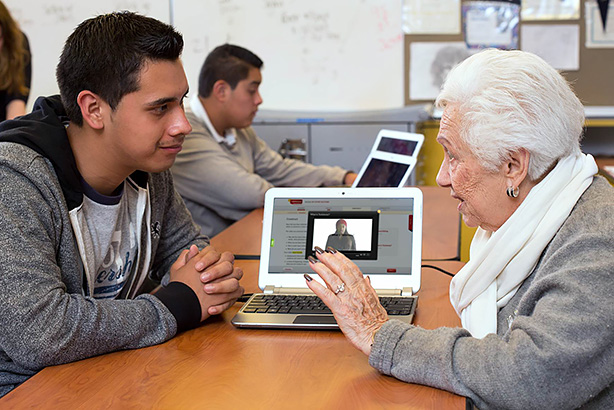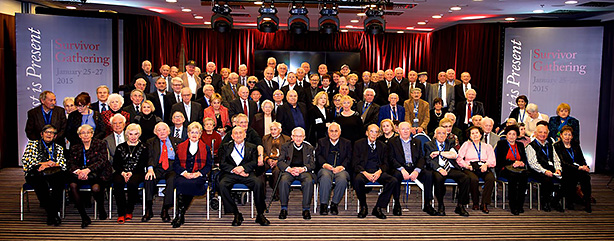
Holocaust survivor Renee Firestone talks with students at Camino Nuevo Charter Academy High School in Los Angeles about USC Shoah Foundation's IWitness educational platform. Photo: Tracy Boulian
Alumni key to building Shoah archive and bringing access to Cornell

Douglas Greenberg, M.A. '71, Ph.D. '74.
When Douglas Greenberg, M.A. '71, Ph.D. '74, was analyzing 6,000 court cases for his dissertation on crime and law enforcement in 18th-century New York City, computers were not in widespread use. But he realized technology could make his research more efficient.
"By hand, it would have been a really labor intensive and difficult task, so I read up on how databases worked, and I was able to build one of my own," says Greenberg, distinguished professor of history at Rutgers University. "I used a big mainframe computer in a big building up by the airport, and I must have been one of two or three people there working in the humanities. It was a strange experience both because it seemed like I was on the deck of the starship Enterprise, and also because no one there understood the problem I was working on. So it was great fun."
Around 30 years later, Greenberg applied a similar approach to another huge volume of information, as executive director of the USC Shoah Foundation: The Institute for Visual History and Education. The institute has recorded more than 53,000 video interviews with survivors of the Holocaust and other genocides. If someone spent 24 hours a day, seven days a week watching videos, it would take more than a decade to view the entire collection.
Under Greenberg's leadership, staff catalogued the videos exhaustively, so users could not only watch and listen to survivors' accounts, but search them by region, name or keyword -- or in many other highly specialized ways. The archive's 112,000 hours of videos are hyperlinked to the minute.
"In a way, its size forced us to find a technology solution that maybe we wouldn't have found with something smaller," he says. "A lot of the skills I was able to bring to the job were, I feel, first acquired at Cornell."
Starting this semester, students, faculty and staff can access the archive remotely, through Cornell University Library computers and elsewhere on campus. Researchers not affiliated with Cornell can access the archive in the library's public computing spaces. Although the precise ways the archive will be used have yet to unfold, several faculty members are discussing ways to integrate it into their syllabi.
"This collection offers incredible firsthand testimonials of the effects of mass genocide campaigns on the survivors," says Anne R. Kenney, the Carl A. Kroch university librarian. The archive complements collections such as the Donovan Nuremberg Trial Collection in Cornell Law Library, and the Division of Rare and Manuscript Collections' Tuol Sleng confessions and photographs from the early 1990s, documenting genocide in Cambodia.
Valuable for future generations

Robert J. Katz '69.
Greenberg isn't the only Cornell alum with an instrumental role in building the archive. Robert J. Katz '69, senior director at Goldman Sachs and former vice chairman of the Cornell Board of Trustees, went from receiving a newsletter from the organization in 1999 to serving on its board in a matter of months. He later became chairman of the foundation's board.
"My fascination with it was a combination of the subject matter, of course, but also fascination with the magnitude of the concept and the execution of what they were doing," Katz says. "First-person video content of actual witnesses seemed to me not just inherently worthwhile, but valuable for future generations."
The Institute for Visual History and Education was founded in 1994 by Steven Spielberg, after he made the movie "Schindler's List." Since then, the institute has become part of the University of Southern California (USC) and has expanded its mission to include survivors of other atrocities, including the Rwandan and Armenian genocides and the Nanking massacre. Its testimonies have been filmed in 63 countries and 39 languages.
The videos' search function makes the information useful and accessible for a wide range of purposes. Administrators at the USC Library say the archive draws interest from scholars in fields as diverse as Jewish studies, history, women's and gender studies, linguistics, media, law and business. Because the survivors talk about their current lives as well as their experience with genocide, the interviews have been used to study recent history, such as the collapse of communism and even the impact of the Chernobyl nuclear disaster, as many survivors live in former Soviet nations.
"Thousands of faculty and students have written papers, and hundreds of courses have been taught using this tool in the classroom," says Sam Gustman, associate dean and chief technology officer of USC Shoah Foundation and USC Libraries.
The late President Elizabeth Garrett oversaw the institute as USC's provost and spoke at the launch of Cornell's access to the archive in November 2015. It is now part of her legacy at Cornell.
Katz wanted to bring the archive to his alma mater, but he wanted to make sure it had enthusiastic faculty support first. The appointment of Jonathan Boyarin, the Mann Professor of Modern Jewish Studies and professor of anthropology, as chair of the Jewish Studies Program created the momentum Katz sought.
"Clearly this was the kind of resource that fit into what I was thinking Jewish studies can and should be at Cornell," Boyarin says. "I hope it will be used, first of all, as a way to highlight the humanity and creative lives and adaptation of survivors, not only documenting the evil they suffered."
Because the survivors of the Holocaust and other genocides come from such a wide range of backgrounds, the archive is relevant to a wide range of fields, he says.
"The Cornell library has long been a technological leader, so I thought this kind of digital historiography was a natural fit," Katz says. "Because of the interest of our faculty and students in the content … bringing this to Cornell just seemed logical."

Survivors gathered for the 70th anniversary liberation of Auschwitz in January 2015. Photo: Provided by USC Shoah Foundation: The Institute for Visual History and Education